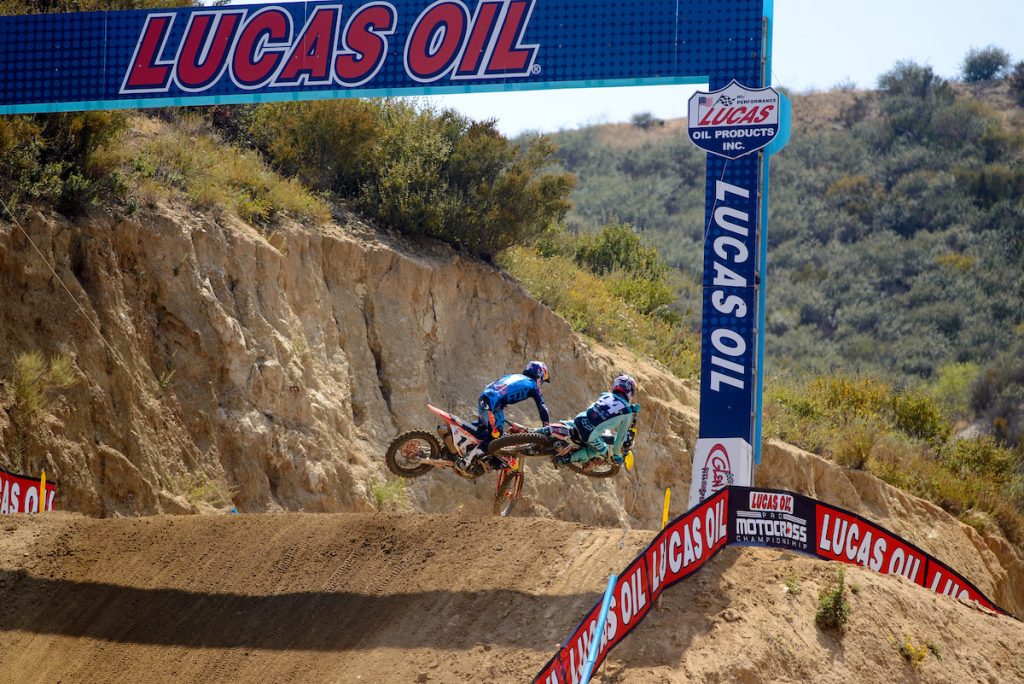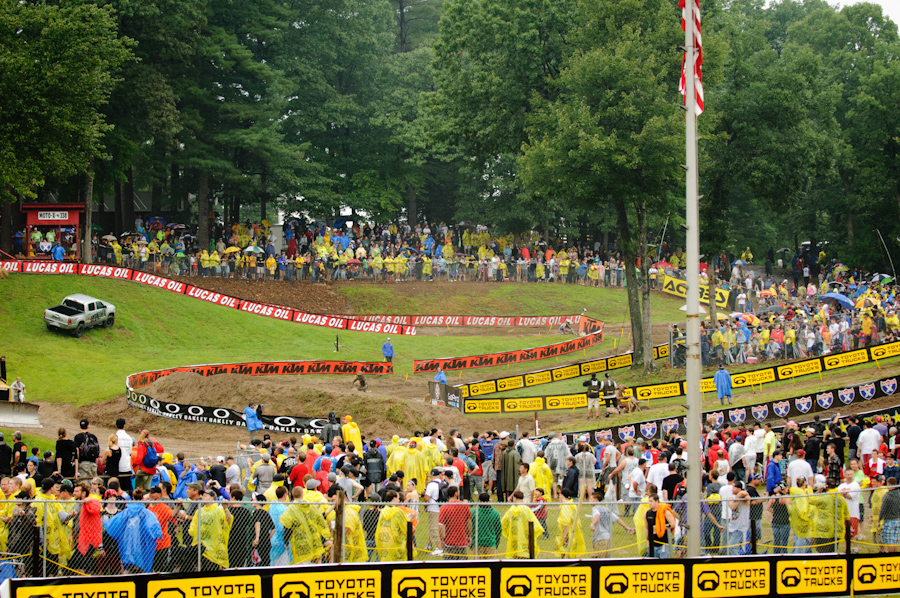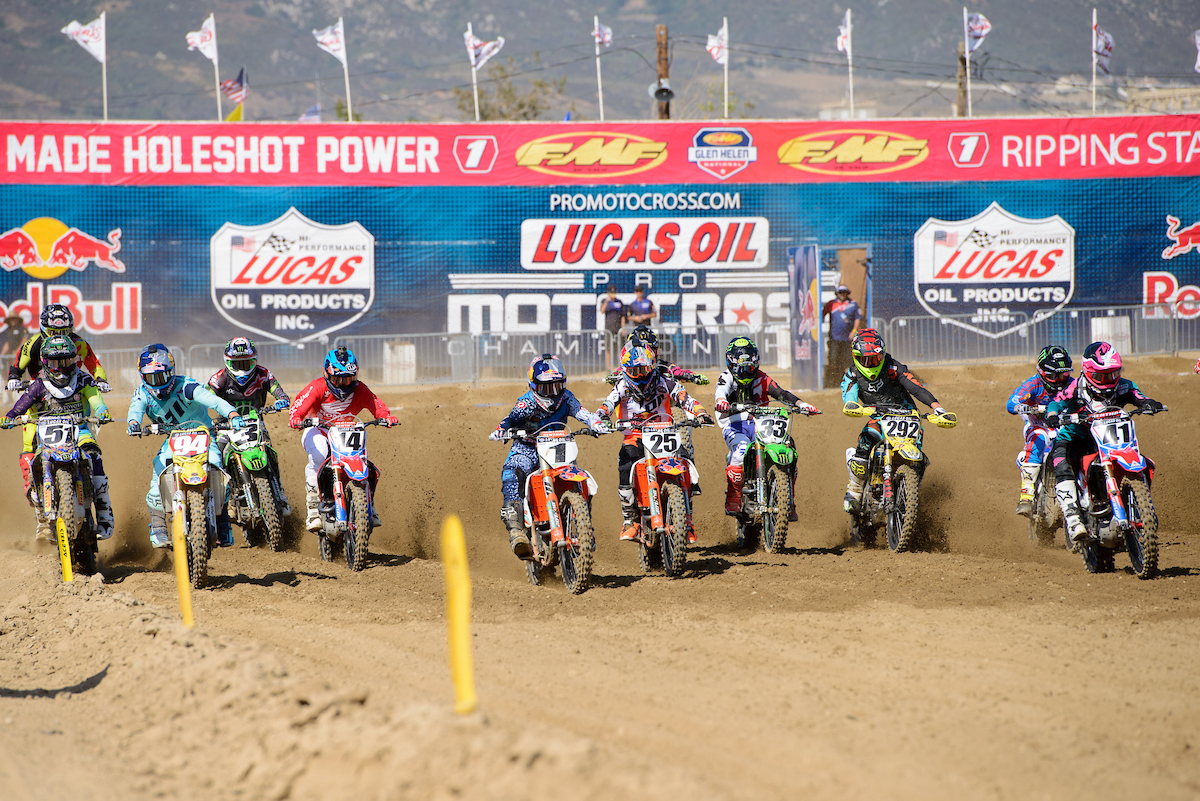The hot as balls days of summer are drawing near and that means it’s time for the Lucas Oil Pro Motocross Championship! Hot temperatures, high humidity, thunderstorms, 30-plus two-lap motos, ginormous braking bumps, back jarring square edges, shroud deep ruts, a 40-rider gate, the smell of barbecue, beer and marijuana in the air and thousands of screaming fans along miles of fence line that surrounds a high-speed outdoor playground. Just thinking of all this should get you jacked up and make your heart rate spike, but for the riders (and mechanics) who have virtually no time off to get prepared for the 12 grueling rounds, it is a huge undertaking. The Monster Energy AMA Supercross series only has one weekend off in the 17-round series and after the final round in Las Vegas on May 5th, the first round of the Lucas Oil Pro Motocross in Sacramento, California is just around the corner on May 19th. That is only two weekends off in a little more than five months! Holy crap! That is not very long to prepare for a completely different form of racing. Yes, it’s dirt bikes, but the set up between the two are totally different. I wanted to break down a few things that you readers/fans may or may not know. As fans all we get to see is the glitz and glamour of the sport, but what is like getting ready for another 12 round series? Let me help break it all down for you die hard fans out there.

Going from supercross to outdoors, the riders have to adjust their practice schedules and how they ride the machine. A perfect example of this is Jeremy Martin. Martin is a two time AMA National 250 Outdoor champion, but has yet to win a 250 regional supercross championship. Why? Does he just suck at supercross? No, of course not. It’s because each discipline takes different types of techniques and supercross practice tracks are not something you see a ton of pro/am riders practicing on day in and day out, coming through the amateur ranks. Growing up I know I didn’t ride much supercross so sometimes it takes longer for a rider (like J-Mart) to get acquainted to the tight confines of stadium racing.
However, when winter rolls around the riders are in full SX mode. From October to late April riders are practicing on supercross tracks that are under one minute in lap times and the racers rarely get their bikes into fourth gear for very long. Going to outdoors they are working with speeds sometimes up to 70 mph, and the racers eyes have to adjust to hitting bumps at high speeds. Riders will usually ride a smoother, faster type of outdoor track on their first few days of outdoor testing just to get their eyes dialed in for the speed. It’s not uncommon to hear a rider say “dude it feels like I am going so damn fast out here” on their first day of riding an outdoor track, after several months of supercross. Lap times on an outdoor track are ranging from two minutes to almost three minutes and when you ask some riders they say “focusing for 40 minutes is much more difficult than just 20 minutes”. Physical and mental fatigue play a big part in hot, longer motos under race intensity.

Another thing riders have to re-adapt to when coming from the stadiums is technique on the bike. Riders are constantly on the front of the bike pushing down on the front end to scrub or soak jumps in SX, yet they need to hang off the back of the bike more for outdoors. Getting traction coming out of a long, muddy rut requires the riders to move toward the rear of the bike and prepare for the hundreds of square edges and bumps they are about to hit.
When watching your favorite riders on TV or when you’re at a Pro Motocross race live, watch how they enter or roll their corners in outdoors compared to indoors. In stadiums, riders square up corners a lot and rear brake slide to pivot them down the next lane. In outdoors rarely will you see this maneuver. Rolling corners, getting on the gas sooner (through corners) and using the front brake is key to carry the most speed around a motocross track. All of these little things add up when tackling an outdoor track and take some time to get used to.
The suspension in supercross is ridiculously stiff (especially the fork setting) in order for riders to hit faces of jumps and stay low. Skimming whoops takes a stiff setup as well to keep the bike from pitching back and forth. In outdoors the suspension must stick to the ground (for maximum traction) while also being soft enough to soak up all of the bumps that accompany a deeply tilled, watered outdoor track. So when racers jump back on their outdoor suspension settings the bike often feels too soft and it’s not uncommon to hear them complain about the bike being too active or mushy. Riders have to adjust to the bike actually moving in the stroke instead of the bike’s attitude having a “dead” feel and not moving at all.
As you know riders are big time head cases right? So…. It can take some persuading to convince them that everything will be fine and they just need to ride the bike a little more. After they have got some time under their belts additional settings can be gone through. The engines are known to be smoother off the bottom-end and rev much farther for the long straights in the great outdoors. This will usually be done through remapping the fuel/ignition settings and making gearing changes. In supercross riders want more bottom-end to get over rhythms immediately out of corners and will sacrifice some top-end. Outdoors riders have to ride an engine character for almost 40 minutes, so a little friendlier power delivery, that is much easier to manage, for the duration of two long motos is better.

Some teams and riders run bib mousse inserts in their tires to prevent flats and that creates a different feel on the bike as well. Most motocross riders prefer traditional inner tubes for contact feel and lean-in traction feeling. With mousse inserts riders have to get used to a less absorbent tire carcass feeling and the mousse gives more of a “dead” feel over braking bumps. If riders don’t like the bib mousse feel, teams will accommodate riders by drilling holes into the foam inserts for a softer feel.
A rider going from indoors to outdoors will also be noticing a more taxing feeling on their bodies. Instead of doing sprints and short, quick bursts for speed, riders will transition into doing longer motos during the week in hot and humid conditions to train their bodies for the sun. Recovery is also more important during the summer months as riders will dehydrate more racing 60-plus minutes on a Saturday afternoon. Instead of practicing four times a week like riders do during the supercross season, most riders will back it down to maybe two to three days a week during the outdoor season. Off the bike training is not as strenuous, more recovery bicycle rides that are longer in duration (two hours) and a lower heart rate dominate riders training schedules.
As Matthes would say “the rider is only as good as his bike and mechanic allow him to be”. I am even leery to write this part of the article because Matthes will start talking about the Tim Ferry days again. A mechanic’s job can be just as stressful as a rider’s during the week and on race day. In the old days at supercross the mechanics usually had more time to change parts, prepare and get the machine ready for the night show and main event. In today’s live television world the schedule is much tighter and the bikes endure so much more abuse than in supercross.

For a full day/night of supercross racing the bike has maybe 45-50 minutes of total time on the chassis/engine. In motocross the chassis/engine has more than 90 minutes on it between motos and is much filthier with mud than in supercross. Not to mention that for those 90 minutes or so, the engine rpm was higher and ringed out longer than a supercross race. Testing is also much harder to do as most of the manufacturers and teams are based on the west coast, which means testing happens on the west coast. But what happens when the riders “west coast” test settings don’t work on east coast dirt? Unlike supercross, where settings very rarely change from track to track, outdoor motocross presents a whole new challenge in bike setup. Again, riders are head cases and will swear their bike is reacting differently from the previous round’s setting. When things like that happen, teams sometimes have to rely on their notes from past years race settings, at a particular track, in order to get a good baseline for a rider at any given round.
As you can see there are many differences between the machine, the rider and the mechanic for each discipline. We also wanted to throw in the differences between manufacturer contingency for the 2018 Lucas Oil Pro Motocross Series compared to the Monster Energy Supercross Series. You will notice some differences in payout between each series and in Honda’s case the rider can make MORE money racing outdoors than supercross. What? Yes, thats right! For example if you go 15-15 at Hangtown you are making $1,100 versus making $650.00 in supercross. Now we will have to take in consideration that the bike has more wear and tear racing outdoors, but if you choose the right brand of bike a privateer can make some money racing during the day on Saturday’s.
HONDA:
SX: MX:
Breakdown: 450 Breakdown: 450 (Per Moto)
1. 15,000 1. 5,000
2. 7,500 2. 3,000
3. 5,000 3. 2,000
4. 3,000 4. 1,750
5. 2,500 5. 1,500
6. 2,000 6. 1,250
7. 1,750 7. 1,000
8. 1,550 8. 900
9. 1,250 9. 850
10.1,000 10. 800
11. 900 11. 750
12. 800 12. 700
13. 750 13. 650
14. 700 14. 600
15. 650 15. 550
16. 600 16. 500
17. 550 17. 450
18. 500 18. 400
19. 450 19. 350
20. 400 20. 300
21-30. 200
31-40. 150
Breakdown: 250 Breakdown: 250 (Per Moto)
1. 10,000 1. 5,000
2. 7,500 2. 3,000
3. 5,000 3. 2,000
4. 3,000 4. 1,750
5. 2,500 5. 1,500
6. 2,000 6. 1,250
7. 1,750 7. 1,000
8. 1,550 8. 900
9. 1,250 9. 850
10.1,000 10. 800
11. 900 11. 750
12. 800 12. 700
13. 750 13. 650
14. 700 14. 600
15. 650 15. 550
16. 600 16. 500
17. 550 17. 450
18. 500 18. 400
19. 450 19. 350
20. 400 20. 300
21-30. 200
31-40. 150
Kawasaki:
SX: MX:
Breakdown: 450 Breakdown: 450 (Overall)
1. 25,000 1. 25,000
2. 15,000 2. 15,000
3. 5,000 3. 5,000
4. 2,500 4. 2,500
5-10. 1,000 5. 1,000
11-22. 500 6-10. 750
11-20. 500
21-40. 250
Breakdown: 250 Breakdown: 250 (Overall)
1. 25,000 1. 25,000
2. 15,000 2. 15,000
3. 5,000 3. 5,000
4. 2,500 4. 2,500
5-10. 1,000 5. 1,000
11-22. 500 6-10. 750
11-20. 500
21-40. 250
Yamaha:
SX: MX:
Breakdown: 450 Breakdown: 450 (Overall)
1. 15,000 1. 15,000
2. 5,000 2. 10,000
3. 4,000 3. 5,000
4. 2,000 4. 2,500
5. 1,000 5. 1,000
6-10. 600 6-10. 500
11-15. 500 11-15. 350
16-20. 400 16-20. 250
21-22. 300
Breakdown: 250 Breakdown: 250 (Overall)
1. 15,000 1. 15,000
2. 5,000 2. 10,000
3. 4,000 3. 5,000
4. 2,000 4. 2,500
5. 1,000 5. 1,000
6-10. 600 6-10. 500
11-15. 500 11-15. 350
16-20. 400 16-20. 250
21-22. 300
KTM:
SX: MX:
Breakdown: 450 Breakdown: 450 (Overall)
1. 15,000 1. 15,000
2. 7,500 2. 7,000
3. 5,000 3. 5,000
4. 3,000 4. 3,000
5. 2,500 5. 1,250
6. 2,000 6. 1,000
7. 1,750 7. 950
8. 1,500 8. 900
9. 1,250 9. 850
10. 1,000 10. 800
11-22. 500 11-22. 600
Breakdown: 250 Breakdown: 250 (Overall)
1. 15,000 1. 15,000
2. 7,500 2. 7,000
3. 5,000 3. 5,000
4. 3,000 4. 3,000
5. 2,500 5. 1,250
6. 2,000 6. 1,000
7. 1,750 7. 950
8. 1,500 8. 900
9. 1,250 9. 850
10. 1,000 10. 800
11-22. 500 11-22. 600
Husqvarna:
SX: MX:
Breakdown: 450 Breakdown: 450 (Overall)
1-10. 600 1-10. 600
11-22. 400 11-22. 400
Breakdown: 250 Breakdown: 250 (Overall)
1-10. 600 1-10. 600
11-22. 400 11-22. 400





